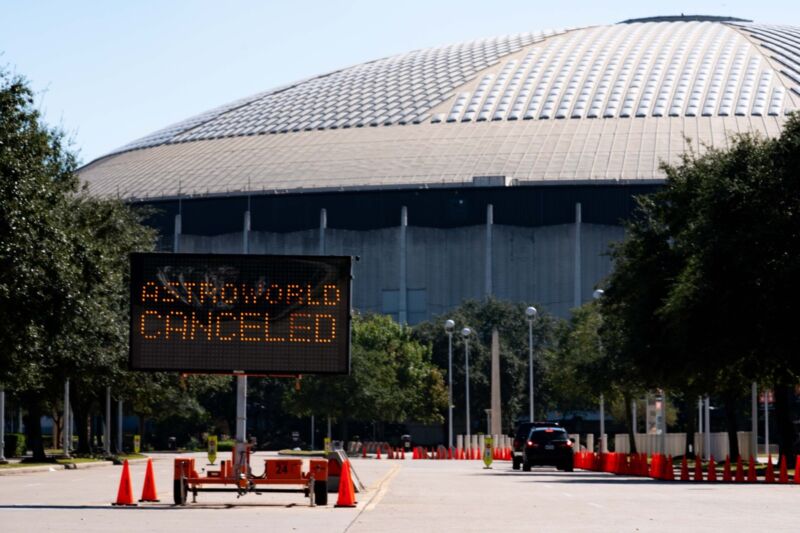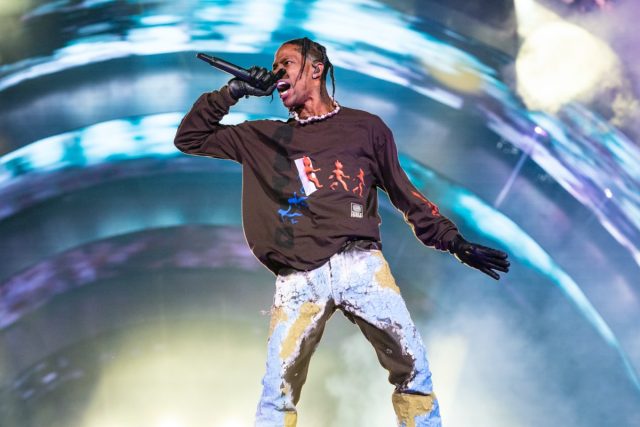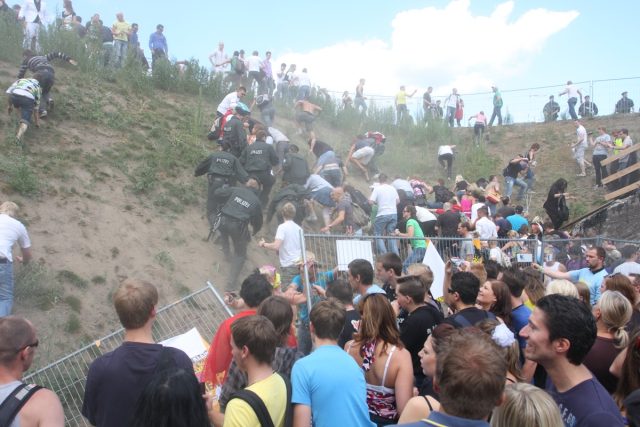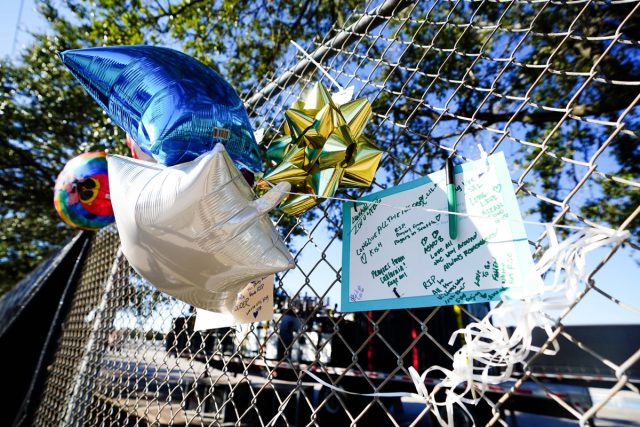
The Astroworld music festival in Houston, Texas, kicked off last Friday, but tragedy struck when Grammy-nominated rapper Travis Scott—who launched the festival in 2018—took to the stage around 9 pm. The enthusiastic crowd surged toward the stage and packed the mosh pit so tightly that people couldn't breathe and began to pass out. There was no space to move, and in the end, at least eight people were killed, and another 25 were hospitalized.
Concert promoter Live Nation issued a statement saying it was "heartbroken for those lost and impacted at Astroworld," and the company pledged its full cooperation with local authorities who are investigating. As for Houston native Scott, he pronounced himself "just devastated" in a video posted to his Instagram account last Saturday night and said he had not realized how severe the situation had become from his vantage point onstage. The rapper seems equally reluctant to take the stage in the immediate aftermath of the tragedy: Scott has reportedly canceled a planned set at the hiphop "Day N Vegas" festival, with sources telling Vulture the rapper is "too distraught to play."
There is still a great deal we don't know about the conditions at Astroworld and what actually happened that night, pending the results of an official investigation. But deadly crowd surges are a far too common occurrence all over the world. For instance, back in 1979, 11 people were trampled to death during a Who concert in Cincinnati. In 2000, nine people were trampled to death at a Pearl Jam concert during Denmark's Roskilde Festival. And in April of this year in Meron, Israel, 45 people died in a crush at the Lag B'Omer religious festival, with 150 more injured.

Scientists have been studying crowd dynamics for decades in hopes of developing better strategies to avoid these kinds of tragedies. Typically, they have used computer simulations. Access to archival videos of these kinds of incidents can help, like the footage from the January 2006 Hajj to Mecca. Over 2 million Sunni Muslims were making their way along an established route to the Saudi city. As the route narrowed at the Jamaraat Bridge, the density of the crowd increased drastically, as people rushed to complete the final symbolic stoning ritual at Mina before sunset. A stampede ensued, killing 363. (That death toll, while high, pales in comparison to the roughly 2,400 pilgrims killed in another stampede near Mecca in 2015.)
Dirk Helbing and Anders Johansson of the Dresden University of Technology were able to analyze the video footage and developed a computer algorithm to track the position and velocity of every person in the crowd over a 45-minute period. They identified three distinct phases of the crowd's motion. The crowd initially moved toward the bridge at a steady rate, but as the density increased, there was an abrupt phase transition to a kind of "stop-and-go" motion. This spread like a wave in the same direction the pilgrims were moving. The crowd density continued to increase until another sudden phase transition occurred, whereby pilgrims started moving randomly in all possible directions.
Helbing and Johansson dubbed this phenomenon "crowd turbulence," or a "crowd quake," and they found the critical threshold seemed to be about six people per square meter (10 square feet). "The researchers believe that turbulence may have been brought on by individuals panicking and pushing in all directions to increase their personal space," Hamish Johnston wrote in Physics World in 2007. "This caused violent pressure waves to surge through the crowd, tossing individuals several metres, tearing off clothing and ultimately leading to the trampling of hundreds of pilgrims."

The Jamaraat Bridge scenario is an example of a bottleneck. A similar bottleneck occurred in Eastern Germany during the 2010 Love Parade, a popular music festival. The bottleneck in this case was a 200-meter-long tunnel, through which attendees had to pass in order to get to one of the festival events. But the passageway was too small to handle such an immense crowd, and the density soon increased to dangerous levels. Police tried to block more people from entering the jammed parade grounds, triggering a stampede. People began to suffocate around 5 pm as thousands of other revelers danced to techno music, unaware of the tragedy that was unfolding nearby. In the end, 21 people died, and 651 were injured.
The Astroworld tragedy seems to have been centered on the crowd packed into the mosh pit rather than a more typical bottleneck scenario. There was a 2013 study on mosh-pit dynamics by a group of physics students at Cornell University, inspired when co-author Jesse Silverberg attended a heavy metal concert with his girlfriend. He wisely avoided the mosh pit and, like a true physicist, found himself fascinated by the motion of the crowd, which struck him as resembling the disordered collisions of molecules in a gas.
Silverberg and his co-authors decided to simulate mosh-pit dynamics. They drew on footage from rock concerts posted on YouTube and used a particle tracking program to convert everyone in those crowds into individual particles, dubbed MASHERS (Mobile Active Simulated Humanoids). There were two kinds of MASHERS: passive ones who stayed stationary after an accidental collision, and active ones who bounced after a collision. The researchers found that, when there were more active MASHERS than passive ones, the crowd did indeed behave like molecules in a gas, with random collisions. But sometimes, spontaneous "flocking" would occur, in which MASHERS began following their neighbors' motions. In that scenario, vortices would form—basically human whirlpools.
Of course, people aren't particles, and Silverberg et al. freely admitted they were using very simple mathematical models. Human beings are complicated and unpredictable, which is why there has been a great deal of recent work attempting to incorporate the human factor into the modeling of crowds.
For instance, a 2015 study by scientists at the University of Technology in Iran created a simulation that included so-called "emotional contagion." In it, the simulated people became increasingly fearful and panicked—expressed as increasingly random movement—as they failed to find an exit from the crowded virtual environment. Similarly, a 2018 study by University of Plymouth researchers figured out how to measure the kinetic energy of crowds in real-time videos, using that as a gauge to identify areas where the crowd was transitioning into a dangerous emotional state.
Dinesh Manocha, a computer scientist at the University of Maryland, has conducted several studies on crowd behavior. He has sought to incorporate not just physics and physiology but also psychology into his models. That said, "In many ways, we don't have access to the exact data, situation and crowd movement that occurs at such tragedies," Manocha told Ars. "You typically hear the experiences of a few attendees or some isolated pictures and videos that do not provide all the details." Nonetheless, there are two factors he has observed in his research over the years that seem common to all such tragedies.
The first, as we've seen, is density—specifically, situations where crowd density reaches more than four people per square meter. "In many ways, each human or pedestrian loses his/her capability to move independently in such density, but rather they become part of a macroscopic flow," said Manocha. "So crowd tragedies are more likely to happen in such scenarios, as humans lack the ability to escape from the crowd flow."
Multiple media reports of the Astroworld tragedy have referenced the high density and chaos of the crowd, particularly in the mosh pit. "This was preventable," concert-safety consultant Paul Wertheimer told the Los Angeles Times. "The crowd was allowed to get too dense and was not managed properly." He believes the popularity of "festival seating," on a first-come, first-serve basis (as opposed to having reserved seats) exacerbates the problem, since concertgoers can pack in at much higher densities.
The second factor influencing crowd surges, per Manocha, is individual behaviors. "The individual personalities of the participants plays a major role," he said. "Some of them tend to be aggressive, while others can cause or spread panic." He and his colleagues have explored how individual personalities and behaviors impact the flow and movement of a crowd. "However, we can’t validate these models completely in real-world crowd disaster settings because of lack of sufficient data," he said. "For example, we do not have any information about the behavior and personalities of all the individuals that were present."

According to Manocha, many event-management companies now deploy lots of camera systems to capture high-resolution footage of individual people in a crowd, which can in turn be analyzed with computer vision techniques. He has found this useful for searching for individual behavioral cues, such as aggressive behavior, panic, and rapid movements, which could trigger dangerous crowd surges.
"For example, we have good technologies that can forecast severe thunderstorms, tornadoes, hurricanes, or snow storms," said Manocha. "That provides enough warning to the public and law enforcement authorities. Similarly, we can deploy a lot of cameras that can monitor these crowds in all parts of such stadiums or concert venues. The AI software can automatically monitor the movements and behaviors and provide warning signs to the law enforcement authorities in advance."
In the meantime, there are several precautions one can take to stay safe in dangerously crowded conditions, according to Mehdi Moussaid, a researcher at the Max Planck Institute for Human Development. He had just completed his doctoral thesis on the movement of crowds when the 2010 Love Parade disaster occurred, and he has been researching crowd dynamics ever since. In a 2019 article for The Conversation—which is updated regularly, a testament to the unfortunate prevalence of such crowd surge events—Moussaid offered several survival tips for people who find themselves in potentially dangerous crowded situations.
Ideally, one should be able to identify when the crowd is becoming too dense: if you're accidentally bumping into a couple of people around you, moving to a less congested area might be a good idea. If you can't move your hands freely, you are now in a dangerous crowd condition.
Moussaid's tips in this scenario include trying to remain upright to avoid being trampled; keeping your arms at chest level, folded in front of you to protect your rib cage; avoiding screaming to save your breath, since the majority of deaths in crowds are due to asphyxiation; trying to locate the epicenter of the crush and look for viable escape routes (including scaling a fence or climbing onto a ledge); and trying not to panic. Also, people often try to resist the pressure of the crowd and push back. Moussaid advises going with the flow—unless you're next to a wall, fence, or other barrier, which should be avoided in densely crowded situations.
https://ift.tt/3Ddglch
Bagikan Berita Ini














0 Response to "What the physics of crowds can tell us about the tragic deaths at Astroworld - Ars Technica"
Post a Comment